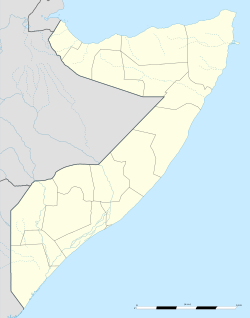Hoosingo
Hoosingo | |
|---|---|
Town | |
| Coordinates: 0°10′31″S 41°16′12″E / 0.17528°S 41.27000°E | |
| Country | |
| Region | Lower Jubba |
| Time zone | UTC+3 (EAT) |
Hoosingo is a district in the southeastern Lower Juba (Jubbada Hoose) region of Somalia. It is situated on the border with Kenya, and its population is estimated to be around 40,000. Hoosingo is entirely populated by the Sheekhaal clan, mainly Awqudub and other Sheekhaal sub clans. It is one of the largest districts in Lower Juba in terms of landmass and is home to over 20 towns. The town is one of the oldest in the Waamo region and has a rich history dating back several centuries. The people of Hoosingo have been peace-loving and are known for their spirituality, being the pioneers of the old Islamic spread across Somalia. The town is a hub for Islamic learning, with many scholars coming from the area. The economy of Hoosingo is primarily based on livestock, with the town being one of the largest livestock markets in the region. Livestock is the primary source of income for many families, and it is often traded for food, goods, and other services. Additionally, there are small businesses in the town that provide services to the local community, such as shops and restaurants. The region has been home to large wildlife populations before the civil war but has been depleted due to a lack of conservation and hunting.
However, one of the most tragic events in recent history is the Hoosingo massacre, which occurred on December 20, 2011. The Kenyan Defense Forces bombed the town, killing over 20 innocent people, including women and children. The attack was part of Kenya's military incursion into Somalia to combat the Al-Shabaab terrorist group. The bombing caused significant damage to the town's infrastructure, and many buildings were destroyed. credible sources indicate that a rival clan militia, who were collaborating with the Kenyan soldiers, deliberately furnished the security forces with fabricated intelligence that Hoosingo was an Al-Shabaab stronghold, which was grossly inaccurate. It is alleged that these militia members had a long-standing resentment and animosity towards the residents of Hoosingo as a result of the prolonged and entrenched clan conflicts, and their actions were a deliberate attempt to cause harm and destabilize the community. The Hoosingo massacre still remains a source of controversy and tension between the local people and Kenyan soldiers who are still stationed in the town. To date, no one has been held accountable for the deaths, and the incident has been concealed, and there has been no mention of it. The attack was a blatant violation of international law.
The region is also prone to droughts and other natural disasters, which have had a severe impact on the local economy and the livelihoods of the people of Hoosingo. this has resulted in increased poverty, underdevelopment, and lack of access to basic services such as education and healthcare. At the administrative level, Hoosingo is situated in Jubbaland, however, it has not been receiving the necessary support and attention from the regional authorities. The town has been subjected to neglect and huge subversion efforts from the administration, which has led to its portrayal as a no-go zone. As a result, NGOs have been granted limited access to the area, hindering the provision of essential services to the community.
Despite these challenges, the local administration, supported by the efforts of the residents and the diaspora, has been making significant strides in addressing the basic needs of the population. The provision of services such as schools, water, and healthcare has been improving, thanks to the tireless efforts of the community. The lack of support from the regional authorities has had a profound impact on the town's development, hindering its potential for growth and prosperity. The limited access to NGOs and international organizations has made it difficult to access critical resources and funding, further exacerbating the challenges faced by the community.
In Hoosingo there is steeped rich tradition of ancient and time-honoured traditional leadership that has endured for centuries. This traditional governance has been the bedrock of the community's self-rule and harmonious co-existence with neighbouring clans. They have played a pivotal role in conflict mediation and resolution in the region, earning the admiration and respect of many.
Suldan Abdullah Haji, one of the most celebrated Hoosingo traditional leaders, was once the overall Suldaan of the 'Aji' Somali clans in the Waamo regions. He fiercely advocated Somalia's self-rule, using his position and influence to fight colonialism and foreign domination. With the aid of the army commanders the 'Sagaales' who represented different sub-clans in the district, he protected and preserved the community's cultural heritage, ensuring that it remained intact for future generations.
Today, the traditional leadership still flourishes in Hoosingo, with the clans being led by the 'sagaale'. The successor of Suldan Abdullah Haji traditional, his son, Suldan Mohamed Suldan Abdullahi Haji, has followed in the footsteps of his predecessors, working tirelessly for the betterment of his people and the entire Waamo region. His leadership has been characterized by boldness, vision, and a deep commitment to his people's welfare.The longstanding tradition of leadership in Hoosingo has been the backbone of the community's peace, stability, and progress. It has fostered a strong sense of belonging and unity, ensuring that everyone's voice is heard, and everyone's interests are protected
References[edit]
- https://www.garoweonline.com/en/news/somalia/kenya-forces-kill-20-civilians-in-hoosingo-somalia.
- http://sdrb.gov.so/regions/lower-jubba
- https://www.amnesty.org/en/latest/news/2011/03/somalia-troops-kenya-allegedly-bombed-civilians-lower-jubba/.
- Hoosingo
- https://www.so.undp.org/content/somalia/en/home/countryinfo/jubbaland-state-of-somalia.html.
- https://reliefweb.int/report/somalia/somalia-humanitarian-bulletin-1-july-31-august-2020.

